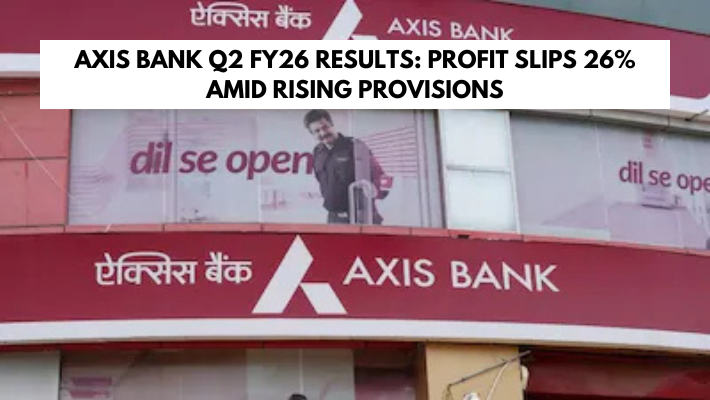Axis Bank Q2 FY26 Results — Navigating Headwinds, Holding Ground
Mumbai, October 15, 2025: Axis Bank Ltd, India’s third-largest private sector lender, reported a 26% year-on-year (YoY) decline in its standalone net profit to ₹5,090 crore for the second quarter of FY26, weighed down by elevated provisions and weaker trading income. While core lending operations remained stable, the bank’s profitability was dented by a one-time regulatory provision and margin compression. Axis Bank’s Q2 FY26 earnings show a ~26 % year-on-year fall in net profit to ~₹5,090 crore, weighed down by one-time provisions and weak trading income.
Key Financial Highlights
| Metric | Q2 FY26 | Q2 FY25 | YoY Change |
|---|---|---|---|
| Net Profit | ₹5,090 crore | ₹6,627 crore | ↓ 26% |
| Total Income | ₹39,770 crore | ₹39,200 crore | ↑ 1.4% |
| Net Interest Income (NII) | ₹13,745 crore | ₹13,450 crore | ↑ 2% |
| Net Interest Margin (NIM) | 3.73% | 3.99% | ↓ 26 bps |
| Gross NPAs | 1.46% | 1.44% | ↑ 2 bps |
| Net NPAs | 0.44% | 0.36% | ↑ 8 bps |
| Provisions & Contingencies | ₹3,547 crore | ₹2,200 crore | ↑ 61% |
| Advances Growth | +12% YoY | — | — |
The fall in profit was sharper than market expectations, primarily due to one-time standard asset provisioning related to discontinued agricultural loan products, and a decline in treasury income caused by volatile bond yields.
Axis Bank Q2 FY26 – Detailed Analysis & Key Drivers
Downward Pressure from Provisions & Non-Core Income
The sharp decline in net profit is primarily linked to a steep rise in provisions and contingencies, driven by a regulatory mandate to make a standard asset provision of ₹1,231 crore for two discontinued crop loan products. These write-downs weighed heavily on earnings, pushing the bottom line downward.
Moreover, trading/investment income took a hit: the volatile bond market and changes in yields reduced gains from treasury operations, compounding the impact.
Core Lending Held Up Better
Despite the headwinds, Net Interest Income grew modestly (~2%) and the total advances book expanded ~12% YoY. This indicates that the core banking business — retail, SME, corporate lending — still retains momentum.
However, Net Interest Margin (NIM) compressed, reflecting pressure from funding costs and competition in lending rates.
Asset Quality: Mixed Signals
- Gross NPAs increased slightly to 1.46%, up from ~1.44% a year ago, signaling some stress.
- Net NPAs held relatively steady at ~0.44%.
- Slippages in the quarter were ~₹5,696 crore, lower than in Q1 FY26 (~₹8,200 crore) but higher than a year ago (₹4,443 crore)
- Recoveries and upgrades were healthy (~₹2,887 crore), offset partially by write-offs (~₹3,265 crore)
Overall, asset quality is under strain, but not yet alarming. The bank’s provision coverage ratio (PCR) was ~70%, down from higher levels in prior quarters.
Outlook & Strategic Considerations
- Reversal Potential from Provisions
The ₹1,231 crore one-time provision is linked to discontinued crop loan products; management has signaled that these may be written back if loans recover or are resolved by March 2028. This creates scope for future upside. - Margin Management Will Be Key
With NIM under pressure, the bank must optimize funding mix, cost of deposits, and pricing of new loans. - Loan Book Quality & Monitoring
Given elevated slippages in recent quarters, focus must remain tight on credit underwriting, monitoring, and recovery mechanisms. - Diversifying Income Streams
To relieve dependence on interest income and volatile trading gains, expanding fee income, digital services, and non-interest streams will be strategic. - Macro & Regulatory Risks
Changes in RBI policy, interest rate movements, inflation, and agricultural sector stress (especially in crop loans) could influence outcomes.
Market Reaction
Following the results, Axis Bank’s shares fell around 1.2% in early trading on the NSE to ₹1,115 per share, as investors reacted to the profit miss. Brokerages remain largely positive on the long-term outlook but expect earnings volatility over the next couple of quarters due to provisioning uncertainties.
Conclusion
Axis Bank’s Q2 FY26 results underscore the balancing act between maintaining credit quality and delivering growth amid regulatory and macroeconomic headwinds.
While the quarter was weighed down by one-time provisions, the bank’s strong capital base, stable core lending, and improving recovery trends suggest a gradual rebound in profitability ahead.




